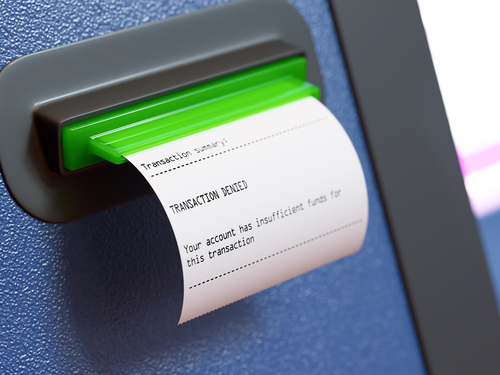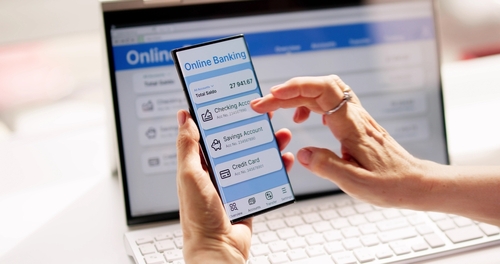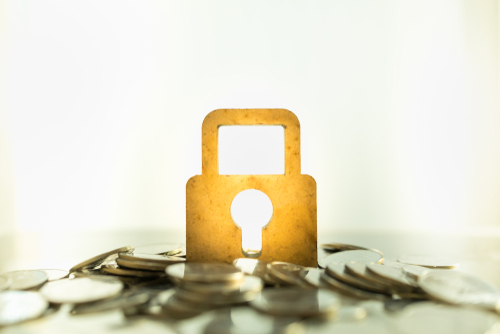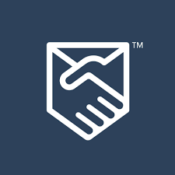Imagine you make a purchase or pay a bill and suddenly realize your account balance isn’t quite enough to cover the amount. We’ve all been there. It’s stressful when a simple purchase turns into a declined transaction or unexpected fee.
Overdraft protection is a service many banks offer to help in these situations. It can act as a safety net for your checking account, covering transactions when funds run low. In this Remitly guide, we’ll walk you through what overdraft protection is, how it works, its pros and cons, and how to decide if it’s right for you.
What is overdraft protection?
Overdraft protection is simple. It’s a service that lets your bank cover transactions that exceed your checking account balance. Instead of having your debit card declined or a check bounce, the bank steps in to cover the shortfall, usually up to an agreed limit.
Think of it as a financial safety net. Just like having a spare tire in your car or a backup battery for your phone, overdraft protection is there for unexpected moments when your checking account doesn’t have enough funds.
Enrolling in overdraft protection
One key point to understand is that overdraft protection is not automatic. You have to opt in for this service. Banks are required by law to get your explicit consent before they can provide overdraft protection for most debit card and ATM transactions. This means you have full control over whether you want to use it.
You can typically enroll through your bank’s website or mobile app, by phone, or by visiting your local branch in person. Once you enroll, it may take a couple days for the service to be fully active. You can also cancel at any time if you decide it’s no longer useful.

How overdraft protection works
Let’s look at a typical scenario to make this more real. Imagine you have $50 in your checking account and a grocery bill of $70. Without overdraft protection, your card would be declined, or the bank might allow the transaction but charge a hefty non-sufficient funds fee. Either way, it’s stressful and inconvenient.
With overdraft protection, your bank covers the $20 difference so the purchase goes through. But where does this money come from? Banks link your checking account to another account or line of credit, which covers the difference.
This process is usually straightforward:
- You attempt a transaction that exceeds your available balance, like paying a utility bill, using your debit card, or writing a check.
- The bank approves the transaction instead of declining it.
- Funds are transferred from a linked account to cover the shortfall.
Types of overdraft protection offered by banks
When your checking account balance isn’t enough to cover a transaction, the bank needs a source to pull funds from. That’s where linked accounts come in. Each option works a bit differently, and understanding them can help you avoid surprise fees or interest charges later.
Savings account transfers
One of the most common and straightforward ways to set up overdraft protection is by linking your checking account to a savings account. In this setup, whenever your checking account doesn’t have enough money to cover a purchase, the bank automatically transfers the necessary funds from your savings.
This method has several benefits. First, you’re using your own money, so there’s no interest to worry about. Many banks also don’t charge a transfer fee, making it a cost-effective solution. It’s simple, predictable, and avoids the complexities of credit-based options.
However, there are a few things to keep in mind. The backup is only as good as the balance in your savings accounts. If your savings are low, you might still face an overdraft situation. Some banks also transfer funds in set amounts, such as $50, which could leave a small amount of your overdraft uncovered or result in slightly higher fees if they charge for each transfer.
Think of it like this: a utility payment goes through when your checking account balance is slightly short. Your bank moves the missing amount from your savings automatically, covering the payment and preventing an overdraft fee. You might pay a $5 transfer fee, but you avoid the $35 overdraft charge or a failed transaction.
Using a savings account can be particularly useful for people who prefer to manage their finances with cash they already have, avoiding interest charges or the temptation to rely on credit.
Credit card advances

Another option is to link a credit card to your checking account for overdraft protection. In this scenario, any overdraft is treated as a cash advance on the credit card. The bank transfers the amount needed to cover the shortfall, and you essentially borrow from your credit card to make the transaction go through.
This method is convenient, especially if you don’t have a large savings account or a separate line of credit. It ensures that even small shortfalls can be covered immediately, keeping your payments and purchases on track.
There are some important considerations. Cash advances typically carry higher interest rates than regular purchases, and interest starts building up immediately. Additionally, your bank may charge a transfer fee for each advance. It’s wise to review your credit card terms carefully before choosing this option, so you’re aware of the potential costs.
For example, if you make a $50 online purchase but only have $40 in your account, your bank might cover the $10 difference from your credit card. It’s a convenient fix, but that $10 starts accumulating interest right away, often at 20% or more annually.
Credit card-based overdraft protection can be helpful in emergencies, but should be used carefully. Without prompt repayment, interest charges can add up quickly, making what started as a small overdraft an expensive one.

Overdraft line of credit
An overdraft line of credit, sometimes called a reserve line, is a slightly more formal, credit-based option. This is a revolving loan that you apply for and receive approval from the bank before using. When your checking account balance runs low, the bank automatically taps into this line of credit to cover the shortfall.
Interest builds up on the borrowed amount, but like other forms of credit, the rate can vary depending on your account and credit score. While this option is more complex than a simple savings transfer, it can be useful if you want to keep your savings untouched or prefer a dedicated backup for emergencies.
Consider a situation where your rent payment clears the same day a utility charge hits, leaving your account unexpectedly short. With an overdraft line of credit, your bank draws from your line of credit to cover the difference, and you repay the borrowed amount once your next deposit comes in.
There are a few key points to consider:
- Revolving credit: This line renews as you repay it, giving ongoing access to funds when needed.
- Interest charges: The borrowed amount will be gathering interest until it’s repaid.
- Credit approval required: Not everyone may qualify, depending on credit history and bank requirements.
This option offers flexibility for those who are comfortable managing credit and want a safety net without moving money from other accounts. It can also help maintain liquidity in your savings for other financial priorities.
The pros of overdraft protection
Overdraft protection comes with clear advantages that make it appealing to many account holders:
- Avoids declined transactions: One of the most immediate benefits is convenience. Your purchases, bill payments, and check can go through without interruption.
- Ensures important payments: Overdraft protection helps ensure that your payments are processed on time, helping prevent additional fees and maintain your good standing with creditors or service providers.
- Provides peace of mind: For people who live on tight budgets or have fluctuating income, the service can offer reassurance. Unexpected expenses can be less stressful when you know you have a financial safety net.
- Flexibility in emergencies: Overdraft protection can give you a small cushion during these moments, helping you manage the situation while avoiding more serious financial consequences.

The cons of overdraft protection
At the same time, it’s important to be aware of the potential downsides. Overdraft protection is not free, and relying on it too heavily can lead to higher costs over time.
- Overdraft fees: Most banks charge a fee each time they cover an overdraft. These fees can be around $35 per transaction, though the exact amount varies. Frequent overdrafts can quickly add up, making this service expensive if used regularly.
- Transfer fees: Some banks charge a smaller fee for transferring funds from a linked savings account. While less than an overdraft fee, it’s still an additional cost to consider.
- Interest charges: If the overdraft is covered by a credit card or line of credit, interest begins building up immediately. Depending on the rate, this can be an expensive way to borrow money, especially if the balance isn’t repaid quickly.
- Can encourage overspending: Knowing that there’s a safety net may lead some people to spend more than they otherwise would. This is particularly relevant if you struggle with budgeting or managing short-term cash flow.
So, overdraft protection is most effective as a backup rather than a regular part of your financial routine. Using it as a crutch rather than a safety net can lead to cycles of fees and interest charges that outweigh its convenience.
Is overdraft protection right for you?
Deciding whether to enroll in overdraft protection is a personal choice, and it often depends on your financial habits and comfort level with risk.
Overdraft protection might be useful if:
- You rarely overdraw your account but want a safety net for emergencies.
- The peace of mind is worth the potential fee.
It might be less helpful if:
- You frequently overdraw your account, as fees can add up quickly.
- You are trying to stick to a strict budget.
If you find yourself using overdraft protection frequently, it might be a sign to revisit your budget or explore banks with more flexible overdraft terms.
Practical ways to stay in control of your finances
If overdraft protection doesn’t feel right for you, there are alternatives to help avoid overdraft fees.
Many banks allow you to set up low-balance alerts through your app or online banking portal. These notifications can help you stay aware of your available funds and prevent overdrafts without paying fees.Another approach is keeping a small buffer in your checking account that won’t be touched for routine spending. This simple habit can reduce the likelihood of accidental overdrafts without enrolling in a formal protection service.
You can also consider using a prepaid debit card. These cards only allow you to spend the money you’ve loaded onto them. Although they offer less flexibility, they can help you stay within budget and avoid fees entirely.
Making the choice that’s right for you
Overdraft protection is a helpful financial tool that can provide peace of mind and convenience when your checking account balance isn’t quite enough to cover a transaction. It helps ensure bills are paid on time and unexpected shortfalls don’t become major problems.
Since it also comes with costs, it’s best to use it as a safety net, rather than relying on it as a strategic backup. Choosing if it’s right for you depends on your spending habits, comfort with risk, and how you prefer to manage your money.
By understanding your bank’s terms, reviewing your options, and considering your own spending patterns, you can make an informed choice about whether it’s right for you.
FAQs
How much does overdraft protection cost?
Costs vary depending on your bank and the type of linked account. You may encounter a flat fee per overdraft, a smaller transfer fee from a linked savings account, or interest charges if a credit card or line of credit is used.
Is overdraft protection the same as overdraft coverage?
Not exactly. Overdraft protection uses a linked account to cover shortfalls. Overdraft coverage allows the bank to pay for transactions without a linked account, usually charging higher fees.
How do I get overdraft protection?
You need to opt in. You can enroll through your bank’s online portal, by phone, or at a branch, and link a savings account, credit card, or line of credit.
Can I turn off overdraft protection?
Yes, you can cancel the service at any time by contacting your bank.

